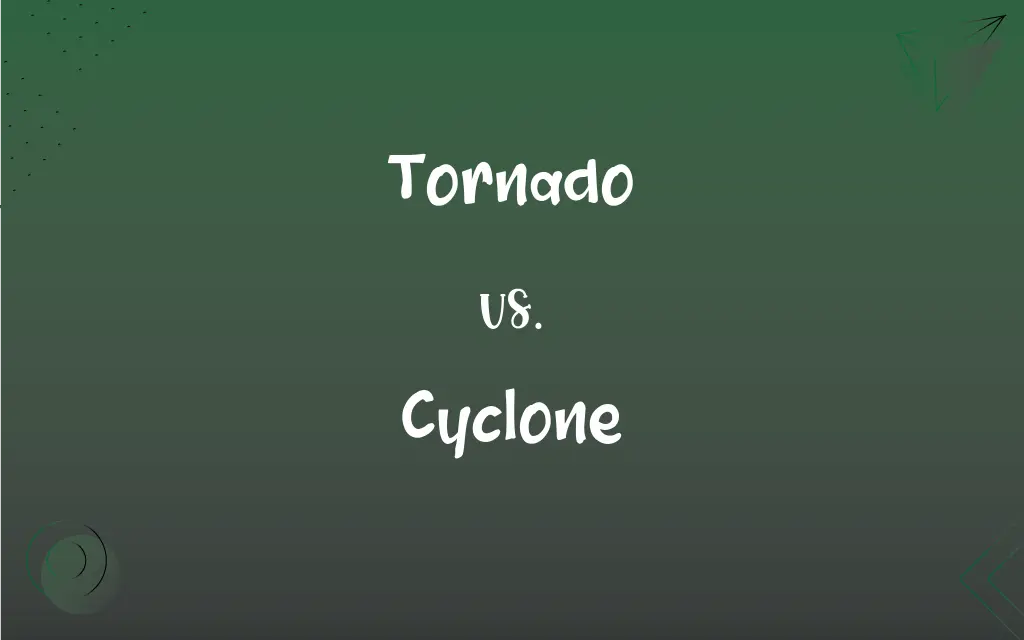Tornado vs. Cyclone: What's the Difference?
Edited by Janet White || By Harlon Moss || Updated on October 8, 2023
A tornado is a violently rotating column of air in contact with the ground and a cumulonimbus cloud, while a cyclone is a large scale air mass that rotates around a strong center of low atmospheric pressure.

Key Differences
Tornadoes commonly emanate from severe thunderstorms and are characterized by a visible, funnel-shaped cloud that extends to the ground. On the other hand, cyclones form over warm ocean waters, gradually developing a system of spiraling bands of rain around a low-pressure center.
The damage caused by a tornado is generally confined to a localized area, given its comparatively narrower path. Conversely, a cyclone impacts a much larger region, often affecting multiple coastal areas and extending inland, causing widespread damage.
The lifespan of a tornado is typically quite brief, sometimes lasting mere minutes, though its wind speeds can be incredibly high, reaching over 300 mph in extreme cases. Cyclones, however, can last for days or even weeks, with wind speeds over 74 mph, causing prolonged adverse weather in affected areas.
Tornadoes can occur in many regions globally, but are most frequent in Tornado Alley in the USA, due to the specific meteorological conditions found there. Cyclones, however, primarily form in tropical and subtropical regions, where ocean waters are sufficiently warm.
While tornadoes are renowned for their rapid onset and departure, providing little warning for affected populations, cyclones typically allow for more preparatory time due to their slower development and movement across oceanic expanses.
ADVERTISEMENT
Comparison Chart
Formation Area
Over land
Over warm ocean waters
Size & Scale
Smaller & local
Larger & affects wide regions
Duration
Brief, usually minutes
Extended, can be days or weeks
Damage Path
Narrow path
Widespread, affecting vast coastlines
Formation Base
From thunderstorms
Around a center of low atmospheric pressure
ADVERTISEMENT
Tornado and Cyclone Definitions
Tornado
A violent windstorm characterized by a twisting, funnel-shaped cloud.
The tornado swept through the town, leaving destruction in its path.
Cyclone
A large-scale atmospheric wind-and-pressure system characterized by low pressure at its center.
The fisherman moved inland to avoid the approaching cyclone.
Tornado
A mobile, destructive vortex of violently rotating winds.
She took shelter in the basement when she heard the tornado approaching.
Cyclone
A violent tropical storm or hurricane, especially in the Indian Ocean region.
Many coastal villages were evacuated due to the threatening cyclone.
Tornado
A weather phenomenon typically associated with thunderstorms.
Meteorologists issued a warning upon detecting signs of a possible tornado.
Cyclone
A weather system in which winds rotate inwardly to an area of low atmospheric pressure.
News outlets continuously updated the public on the cyclone's trajectory.
Tornado
A fast-moving column of air capable of extensive damage.
In mere minutes, the tornado flattened houses and uprooted trees.
Cyclone
A system of winds rotating around a center of low atmospheric pressure.
The cyclone brought heavy rains and strong winds to the seaside town.
Tornado
A weather event with a conspicuously visible funnel extending from a cloud to the ground.
He photographed the tornado as it traversed the open field without causing harm.
Cyclone
A meteorological phenomenon involving large, circulating windstorms.
Aid organizations prepared supplies for areas in the cyclone’s predicted path.
Tornado
A violently rotating column of air extending from a cumulonimbus cloud to the ground, ranging in width from a few meters to more than a kilometer, with destructive winds up to 510 kilometers (316 miles) per hour or higher. Tornadoes are typically associated with a funnel cloud pendant from a storm's wall cloud, often extending to the bottom of the tornado.
Cyclone
An atmospheric system characterized by the rapid inward circulation of air masses about a low-pressure center, usually accompanied by stormy, often destructive weather. Cyclones circulate counterclockwise in the Northern Hemisphere and clockwise in the Southern Hemisphere.
Cyclone
A violent tropical storm, especially one originating in the southwestern Pacific Ocean or Indian Ocean.
FAQs
How fast can tornado winds go?
Tornado wind speeds can exceed 300 miles per hour in extreme cases.
What’s the difference between a tornado watch and a tornado warning?
A tornado watch means conditions are favorable for tornadoes, while a tornado warning means a tornado has been sighted or indicated by weather radar.
What causes a tornado to form?
Tornadoes typically form from severe thunderstorms, particularly supercells, where warm moist air meets cold dry air.
Where are tornadoes most commonly found?
Tornadoes are most common in the United States, particularly in a region known as Tornado Alley.
How are cyclones categorized?
Cyclones are categorized based on their sustained wind speeds, often using the Saffir-Simpson scale.
What should I do during a tornado warning?
Seek shelter immediately, preferably in a basement or an interior room on the lowest floor of a sturdy building.
Can cyclones form at the equator?
Cyclones rarely form near the equator due to the lack of Coriolis force needed to create the rotational movement.
What is a waterspout?
A waterspout is a tornado that forms over a body of water.
How is a cyclone different from a hurricane or typhoon?
The difference lies in the location: "cyclone" refers to such storms in the Indian Ocean and South Pacific, while "hurricane" and "typhoon" refer to the same phenomenon in the Atlantic and Northwest Pacific respectively.
When is cyclone season in the Indian Ocean?
Cyclone season in the Indian Ocean is typically from April to December, with peaks in May and November.
How is the size of a tornado measured?
Tornado size refers to the width of their vortex, not their destructive path or height, and can range from a few yards to over a mile.
Are cyclones and tornadoes related?
While both are atmospheric phenomena involving wind rotation, they differ significantly in size, lifespan, formation conditions, and destructive capacity.
Which areas are most affected by cyclones?
Cyclones primarily impact coastal regions in the tropical and subtropical latitudes.
How do I prepare for a cyclone?
Develop an emergency plan, prepare an emergency kit, secure your home, and heed official advisories, including evacuation orders.
What conditions are conducive for cyclone formation?
Cyclones form over warm ocean waters, with a non-sheared environment and moist mid-troposphere.
How do meteorologists predict tornadoes?
They utilize radar systems and observational data to track thunderstorm development likely to spawn tornadoes.
What is the Fujita scale?
The Fujita scale (or Enhanced Fujita scale) categorizes tornadoes based on the damage they cause, correlating it to estimated wind speeds.
Are cyclones predictable?
Yes, cyclones are trackable and somewhat predictable due to their larger size and slower movement compared to tornadoes.
Is it safe to hide under an overpass during a tornado?
No, hiding under an overpass is dangerous due to increased wind speeds and debris.
What is storm surge in the context of cyclones?
Storm surge is a rise in sea level caused by a cyclone's winds pushing water toward the shore.
About Author
Written by
Harlon MossHarlon is a seasoned quality moderator and accomplished content writer for Difference Wiki. An alumnus of the prestigious University of California, he earned his degree in Computer Science. Leveraging his academic background, Harlon brings a meticulous and informed perspective to his work, ensuring content accuracy and excellence.
Edited by
Janet WhiteJanet White has been an esteemed writer and blogger for Difference Wiki. Holding a Master's degree in Science and Medical Journalism from the prestigious Boston University, she has consistently demonstrated her expertise and passion for her field. When she's not immersed in her work, Janet relishes her time exercising, delving into a good book, and cherishing moments with friends and family.
































































